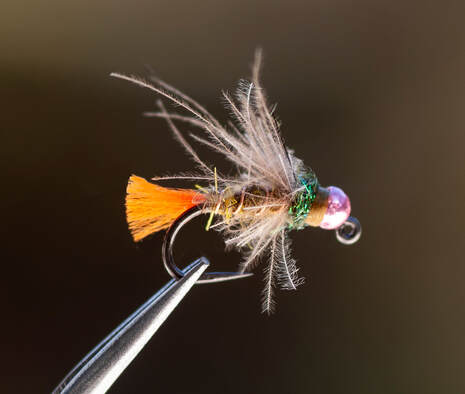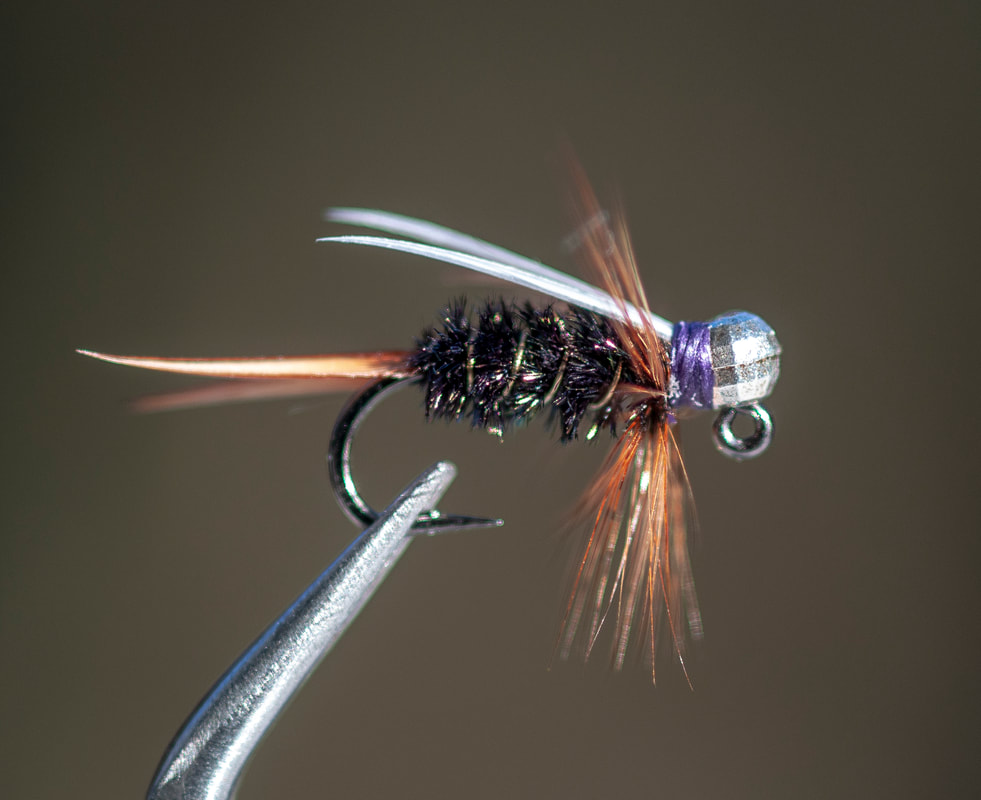Fly of the Month 2.21
Egan's Tasmanian Devil and Royal Prince
It all seemed to begin with the crappie jig that anglers fished deep around bottom structures on ponds, natural lakes and reservoirs where these particular panfish reside. The jig head hook was genius. A fish hook with a weighted head that basically positions itself hook-up in such a manner that it is less likely to catch on bottom structures and be lost. Shop any bait and tackle shop today and the jig hook is a fair portion of the lure variety. Beyond the plain head jig hook, there are painted heads (with eyes) and each in lots of sizes and weights. The crappie jig is a pre-tied Chenille body and marabou tail in a variety of colors but the painted jig heads are used along with soft plastic squiggly tails of numerous designs. Actually, the lightest weight and smallest hook crappie jigs in a variety of colors work amazing well on delayed harvest trout streams.
An early, successful product on the market was the Trout Magnet which uses squiggly material attached to a gold-plated jig hook. So, as fly fishers discovered that these warmwater jig hooks and lures worked well to attract trout, the fly tyers among them began using the plain jig hook to tie nymph fly patterns. Fly Fishing competitions have spawned the genius in anglers of Europe, thus, Euro-Jig fly patterns have steadily evolved. Hook manufacturers are now producing jig hooks in much smaller sizes and weights that meet the demand of the fly fisher.
Tasmanian Devil
“I was introduced to the Tassie Devil [fly] pattern while preparing for the World Fly Fishing Championship last fall in Tasmania. Team USA had the luxury of learning from our skilled guide Maxim Vereshaka. Max recommended we have the pattern tied and ready to fish since it has proven to be effective in their waters and as such is a staple for many Australian competitors...It was my best nymph on the rivers of Tasmania.” - Lance Egan, Team USA
This jig nymph fly pattern has also proven itself as an excellent attractor nymph in our tailwater fisheries here in the United States, especially very cold water. It can be very productive simply as a nymph alone under an indicator,as a trailer nymph following a streamer or as a dropper nymph under a fry fly pattern. The primary advantage of course is the hook-up position that provides a reasonable anti-snagging capability. It is much more complicated to compete with a fly that is more likely to snag. The Tasmanian Devil reliably covers the bottom and has been well proven to catch fish especially under the pressure and time constraints of a competition.
Tasmanian Devil
Fly of the Month 2.21
Tom Adams and Alen Baker
Egan's Tasmanian Devil and Royal Prince
It all seemed to begin with the crappie jig that anglers fished deep around bottom structures on ponds, natural lakes and reservoirs where these particular panfish reside. The jig head hook was genius. A fish hook with a weighted head that basically positions itself hook-up in such a manner that it is less likely to catch on bottom structures and be lost. Shop any bait and tackle shop today and the jig hook is a fair portion of the lure variety. Beyond the plain head jig hook, there are painted heads (with eyes) and each in lots of sizes and weights. The crappie jig is a pre-tied Chenille body and marabou tail in a variety of colors but the painted jig heads are used along with soft plastic squiggly tails of numerous designs. Actually, the lightest weight and smallest hook crappie jigs in a variety of colors work amazing well on delayed harvest trout streams.
An early, successful product on the market was the Trout Magnet which uses squiggly material attached to a gold-plated jig hook. So, as fly fishers discovered that these warmwater jig hooks and lures worked well to attract trout, the fly tyers among them began using the plain jig hook to tie nymph fly patterns. Fly Fishing competitions have spawned the genius in anglers of Europe, thus, Euro-Jig fly patterns have steadily evolved. Hook manufacturers are now producing jig hooks in much smaller sizes and weights that meet the demand of the fly fisher.
Tasmanian Devil
“I was introduced to the Tassie Devil [fly] pattern while preparing for the World Fly Fishing Championship last fall in Tasmania. Team USA had the luxury of learning from our skilled guide Maxim Vereshaka. Max recommended we have the pattern tied and ready to fish since it has proven to be effective in their waters and as such is a staple for many Australian competitors...It was my best nymph on the rivers of Tasmania.” - Lance Egan, Team USA
This jig nymph fly pattern has also proven itself as an excellent attractor nymph in our tailwater fisheries here in the United States, especially very cold water. It can be very productive simply as a nymph alone under an indicator,as a trailer nymph following a streamer or as a dropper nymph under a fry fly pattern. The primary advantage of course is the hook-up position that provides a reasonable anti-snagging capability. It is much more complicated to compete with a fly that is more likely to snag. The Tasmanian Devil reliably covers the bottom and has been well proven to catch fish especially under the pressure and time constraints of a competition.
Tasmanian Devil
Fly of the Month 2.21
Tom Adams and Alen Baker


